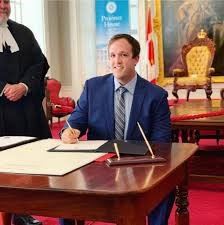We must see more than Charles Sampson and Father Maroun asking the important questions of our elected officials. The politicians are accountable to all of us but the public is dropping the ball by not asking the hard questions of those we select to represent us.
Please read the following letter that Charles Sampson has sent to his MLA, Brian Comer and our Premier, Tim Houston.
In Charles letter, he asks this question:
What is the provincial government’s explanation for the whopping discrepancy between what the federal government, each year, provides in the equalization transfers (this year approximately 23% of $2.458 billion = $565 million) for the provincial municipal property tax capacity deficiency and the provincial government’s equalization Municipal Financial Capacity Grant of $30 million?
Perhaps more should be asking the same. Feel free to copy and paste the above question to your MLA and other elected officials. You deserve an answer and we ask that you share with us, your answer, if any is provided.....
Here is Charles letter that was sent yesterday:
Minister Brian Comer,
As my representative in the provincial legislature, I have forwarded to you below an explanation of what is the current practice with the federal Equalization program and how it has not benefited all Nova Scotians for many years.
Therefore, can you provide a legitimate reason why the Nova Scotia government is unwilling to be accountable and fully transparent to its constituents as to exactly how it is complying with its constitutional obligation under s.36 of the Constitution Act, 1982?
FEDERAL EQUALIZATION AND MUNICIPAL GOV’T UNDERFUNDING
The following paragraph (on p. 71) is taken from the April 2005 report, “A QUESTION OF BALANCE” – An assessment of the State of Local Government in Nova Scotia, prepared for the Nova Scotia Federation of Municipalities:
“Core Expenditures: The main problem with the standard expenditure estimate utilized in the formula as currently implemented is that it accounts for only 40% of the expenditures normally undertaken by Nova Scotia municipalities. Consequently, it should not be surprising to find that the equalization system utilized in Nova Scotia, which equalizes up to a standard that consists of 40% of normal municipal expenditures, does not enable Nova Scotia’s municipalities to provide reasonably comparable local expenditures at reasonably comparable tax rates. In other words, the equalization standard used in the Nova Scotia formula is too low to allow equalization-receiving municipalities to have the resources to ensure that their residents have access to comparable services at reasonable rates of taxation. That is, the core expenditures utilized in the Nova Scotia formula represent an incomplete share of annual costs incurred by municipalities in Nova Scotia.”
https://cbrm.ns.ca/.../A_Question_of_Balance-An...
Since the amount of the Nova Scotia provincial equalization grant has for some years remained unchanged - except for the provincial government’s one time top up this year – this policy must still be in effect.
That is why this one category of the five in the federal Equalization formula pertaining to the province’s municipal deficiency in its tax capacity related to property taxes and miscellaneous revenues continues to send to this province an amount every year which is to enable municipalities to provide reasonably comparable levels of public services at reasonably comparable levels of taxation.
In this way, the federal government continues to send enough funding in these federal equalization transfers, which appears to show it is complying with its commitment pursuant to s.36 of the Constitution Act, 1982. However, the federal government’s practice of sending these Equalization transfers “unconditionally” is responsible for the provincial government’s refusal to provide the transparency and accountability for its distribution within Nova Scotia. And the federal government, despite numerous requests, cannot cite the constitutional reference that would authorize this practice.
Despite the federal funding, five towns have dissolved due to financial problems. Why are many other municipal units also struggling financially?
What is the provincial government’s explanation for the whopping discrepancy between what the federal government, each year, provides in the equalization transfers (this year approximately 23% of $2.458 billion = $565 million) for the provincial municipal property tax capacity deficiency and the provincial government’s equalization Municipal Financial Capacity Grant of $30 million?
Without an explanation, it appears the provincial government’s policy and practice is evidence that it has exempted the government from having to comply with this federal program, which is enshrined in the supreme law of our constitution.
This appears to be the interpretation taken by the provincial government from the C.J. Michael MacDonald’s “Conclusion” in his 2009 N.S, Appeal Court decision regarding the CBRM constitutional challenge. He legally ruled that only the two government parties which were privy to what is represented by s.36 can address this issue. Jurisprudentially, this overruled a prior 1950 Supreme Court of Canada constitutional decision, which ruled unequivocally that the constitution belongs to the country - and not government.
https://www.canlii.org/.../1950canlii26/1950canlii26.html
(see p. 34)
And this is how justice keeps being denied to rural Nova Scotia and the CBRM!
Yours truly,
Charles W. Sampson
Questions To Ask Brian Comer and Every Politician.....
Posted by
Nova Scotians for Equalization Fairness
Receive news by email and share your news and events for free on goCapeBreton.com
SHOW ME HOW
https://capebreton.lokol.me/questions-to-ask-brian-comer-and-every-politician
Gov Government News Federal Government
Gov Government News Municipal Government
Gov Government News Provincial Government
Gov Political Commentary
Location Canada
Location CBRM
Location World
View all the LATEST
and HOTTEST posts
and HOTTEST posts






0
Log In or Sign Up to add a comment.- 1
arrow-eseek-eNo items to displayFacebook Comments